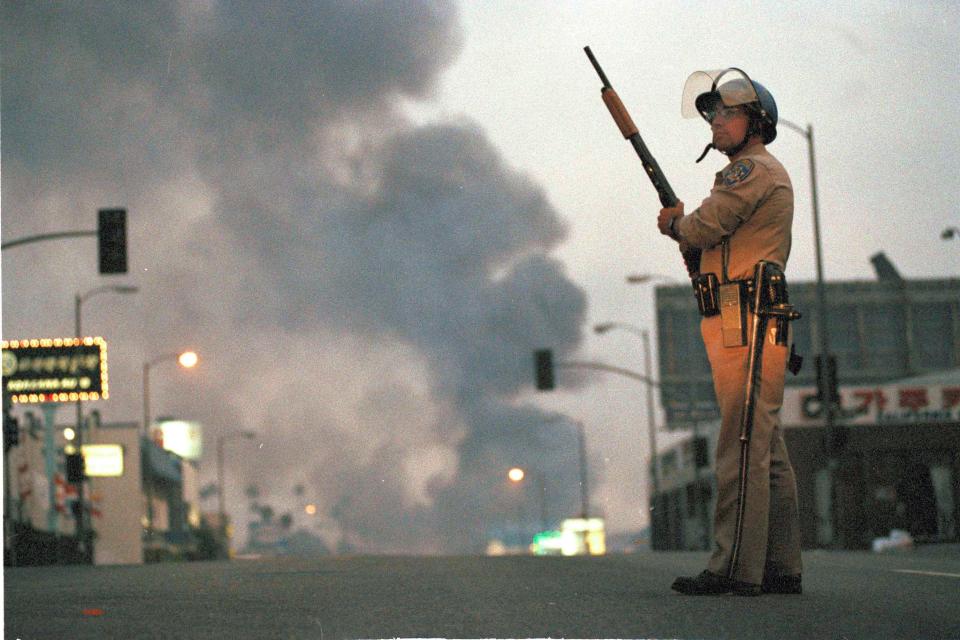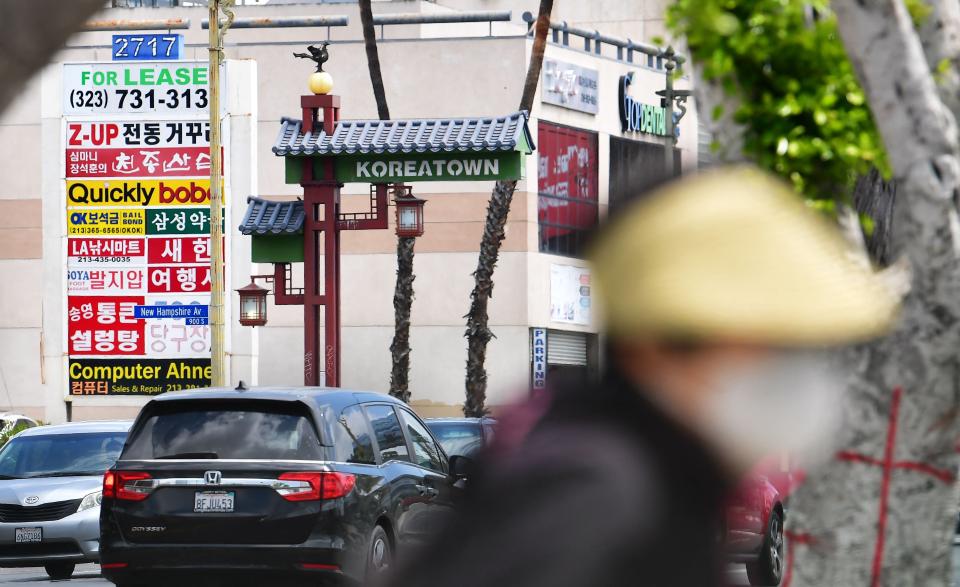30 years after Rodney King case, reconciliation continues for South LA's Black, Korean communities
- Oops!Something went wrong.Please try again later.
LOS ANGELES – John Lee was in his dorm room at California State University, Northridge that late April night in 1992 when he turned on the television and saw Koreatown ablaze.
Lee knew the neighborhood well, having spent many weekends there at his Korean mother's shoe stores. It was now unrecognizable.
Hours before, four white Los Angeles police officers had been acquitted by a mostly white suburban jury in the brutal beating a year earlier of unarmed Black motorist Rodney King.
Outraged residents of South Los Angeles responded to the verdict with fury. Decades of oppression and violence by police spilled over into setting fires and ransacking shops. Abandoned by law enforcement, Korean shop-owners stationed with guns on rooftops to protect their stores.
By the time the unrest ended five days later, more than 2,000 Korean-owned stores were looted, burned, or damaged. All totaled, more than 50 people lost their lives and damages topped $1 billion.
Koreatown’s economy was devastated. While her stores weren't destroyed, Lee's mom lost most of her income. She eventually was evicted from her apartment, and Lee had to move back home to support his family while going to school.
"Our whole life changed," Lee said.
Three decades after the fallout from the April 29, 1992, acquittal put a torch to smoldering tensions between the city's Black and Korean communities, reconciliation efforts continue as residents work to find common ground in shared struggles.

The aftermath
Pressure had been mounting for years as the demographics and economic landscape of the area evolved.
Facing bias in the labor market, Korean immigrants often struggled to make a living and turned to small business ownership as a means of survival, said Brenda E. Stevenson, a former history professor at the University of California, Los Angeles
Meanwhile, Black residents endured a long history of systemic racism, over-policing and economic inequities, including barriers to small business loans. As a result, many grew frustrated watching Korean immigrants open businesses in predominantly Black neighborhoods, said Stevenson, now at the University of Oxford.
The distrust reached a tipping point two weeks after King was beaten, when Latasha Harlins, a Black 15-year-old, was shot and killed in South LA by a Korean American store owner who wrongly accused her of stealing orange juice. A judge gave her probation.
After the shocking verdict in the King beating, Mark Whitlock, then a minister at the First AME Church in Los Angeles, remembers many of his colleagues and friends being angry at the Korean community. But he didn't understand why their anguish was targeted at Korean businesses.
"For me, the unrest was about poor policing in the city of Los Angeles," said Whitlock, who moved to Maryland two years ago and now serves as a pastor there at Reid Temple AME. "It was about the beating of Rodney King and the unjust verdicts."
'SOLIDARITY IS THE ANSWER': Amid a rise in hate crimes, Black and Asian Americans are standing together
That's why he partnered with Korean community leaders, including Hyepin Im, then a student at the University of Southern California, to bridge the two communities.
With Im and others, Whitlock helped organize community conversations and peace marches. He wrote newspaper opinion columns on solidarity and held forums at churches. Pastors at Black and Korean churches began preaching at one another's pulpits.
Days after the city erupted in violence, more than 30,000 people gathered with signs proclaiming “Justice for All Minorities” and “We Shall Overcome.” The multiracial peace march that snaked through Koreatown.
“It was a beautiful sight,” said Edward T. Chang, 36 at the time and now a professor of ethnic studies at the University of California, Riverside.
John Hope Bryant, founder and CEO of the nonprofit economic empowerment organization Operation HOPE, said during the uprising he and local bankers took a bus through what was then called South Central LA. He recalled stopping at a Black-owned pharmacy burned to the ground. It shared a wall with a Korean-owned store, also torched.
The bankers pledged to rebuild the pharmacy, Bryant said, the first investment in reconstruction.
"That first year was the year of conversation," said Bryant. "It set the foundation for the healing that would continue for years after."
BUILDING ON HISTORY: K-12 students are becoming activists, drawing on lessons from fight for ethnic studies

Shared suffering
Media coverage at the time focused on the clash between Black and Korean communities but failed to provide context about the long history of systemic racism that fueled the conflict, said Mary Kunmi Yu Danico, a sociology professor at Cal Poly Pomona in Pomona, California.
“The narrative really dismissed the boiling cauldron that led to this,” Danico said. “This wasn’t just a Black-Korean conflict story ... The bigger challenge is white supremacy pitting communities of color against each other.”
Stevenson, who moved to Los Angeles that year, said in the aftermath, communities were more able to see their shared pain within a racist society.
“Just as African Americans really felt that the court system and the policing system had failed them with regard to Rodney King, the Korean community felt the policing system had failed them in regards to protection of their businesses during the uprising,” Stevenson said. “That systemic racism became quite clear as a result of the uprising.”
Whitlock said focusing on shared struggles was a primary goal of reconciliation efforts.
"We must create a new narrative," he said, "and that's a narrative of the beloved community, a community of unity that overcomes the dark shadows of racism and oppression together."
Chang, who had been a member of LA’s Black Korean Alliance since 1986, was supposed to give a talk in Koreatown about the state of Black and Korean relations in Los Angeles on the day the uprising began.
He said the painful events increased racial awareness in the Korean community and opened dialogues about cross-racial solidarity in a way he had never seen before.
“It really was a turning point,” he said.
SPLC WARNS: Hate groups declined in 2021, but fringe ideology is a 'powerful force' shaping politics

Reconciliation ongoing
Last month, community and political leaders gathered on the steps of Los Angeles City Hall to announce a monthlong commemoration of the events 30 years ago, that came to be known in the Korean American community as "saigu," meaning 4-29.
To mark the anniversary, community leaders repurposed the word to stand for “Serve, Advocate, Inspire, Give and Unite,” said Im, president and CEO of Faith and Community Empowerment, and one of the event organizers.
Im said time has healed some of the wounds of the past, and she has found solidarity among Black community leaders.
“There’s still a lot of healing to be done,” she said.
'PREVENTION IS THE KEY': Fighting anti-Asian hate crimes one year after Atlanta spa shootings
WHAT ADVOCATES SAY NEEDS TO CHANGE: Asian women continue to face 'terrifying' attacks in the US

The three decades of coalition building have come with challenges, Chang said, especially as many went into "survival mode" in the aftermath. Younger generations led the charge, but he said older generations, still reeling from the trauma, continue to be reluctant to bridge divisions.
“For the older folks, it's still very difficult,” he said.
Janelle Wong, a professor of American and Asian American studies at the University of Maryland, said anti-Black sentiment is still present in some Asian communities. Recent, widely-circulated videos of Black men shoving older Asian Americans have served to stoke fear and anger as well as reinforce stereotypes. reinforced stereotypes.
“We didn’t get to the root of the problem," Wong said, "because those (videos) became an easy distraction from white supremacy."
Becky Belcore, co-director of the National Korean American Service & Education Consortium. said helping people understand shared struggles takes time and patience.
“The only way we're going to be able to build true unity and solidarity with Black communities in this country is if we, as Asian Americans, have done our own work around anti-Blackness and around healing from our own trauma,” she said.
Whitlock finds hope in cross-racial organizing in the city and nationwide, as communities stand together against hate crimes.
"We're no longer working in silos," he said. "We're realizing once again that we have more in common than in contrast."
Koreatown today
Today, Koreatown is a lively hub of restaurants, bars and Korean culture – one of the densest neighborhoods in the entire country. The air is filled with smoke from the barbeque restaurants on every block and streets are crowded with 20-something bar hoppers and grandmothers making their weekly grocery trip to H-Mart.
Lee’s parents are still in Los Angeles, retired now, in their 80s. He is a Los Angeles city council member, the second Korean ever to hold the position, and only the third Asian. His mom never returned to Koreatown – her memories of the neighborhood were forever scarred.
Lee is encouraged and inspired by the bustling streets and crowded business. The events of 1992 tore the Black and Asian communities apart, and it took a long time for the neighborhood to recover. But through the pain and tumult, he said, connections were made that weren't possible before.
"It allowed us to share with each other that a lot of the different struggles, a lot of different issues that we were dealing with as individual communities were shared frustrations."
Contact Breaking News Reporter Christine Fernando at cfernando@usatoday.com or follow her on Twitter at @christinetfern.
Contact Breaking News Reporter Celina Tebor at ctebor@usatoday.com or follow her on Twitter at @CelinaTebor.
This article originally appeared on USA TODAY: 30 years after Rodney King: Black, Korean communities in LA reconcile

